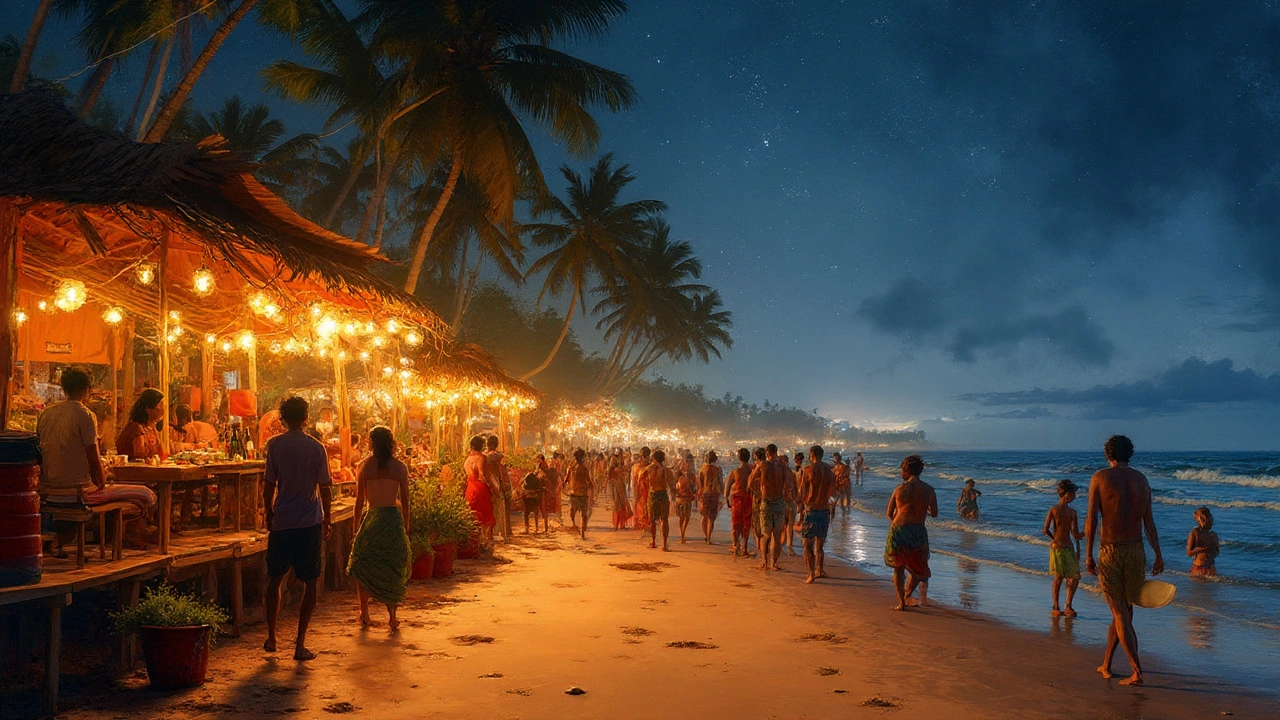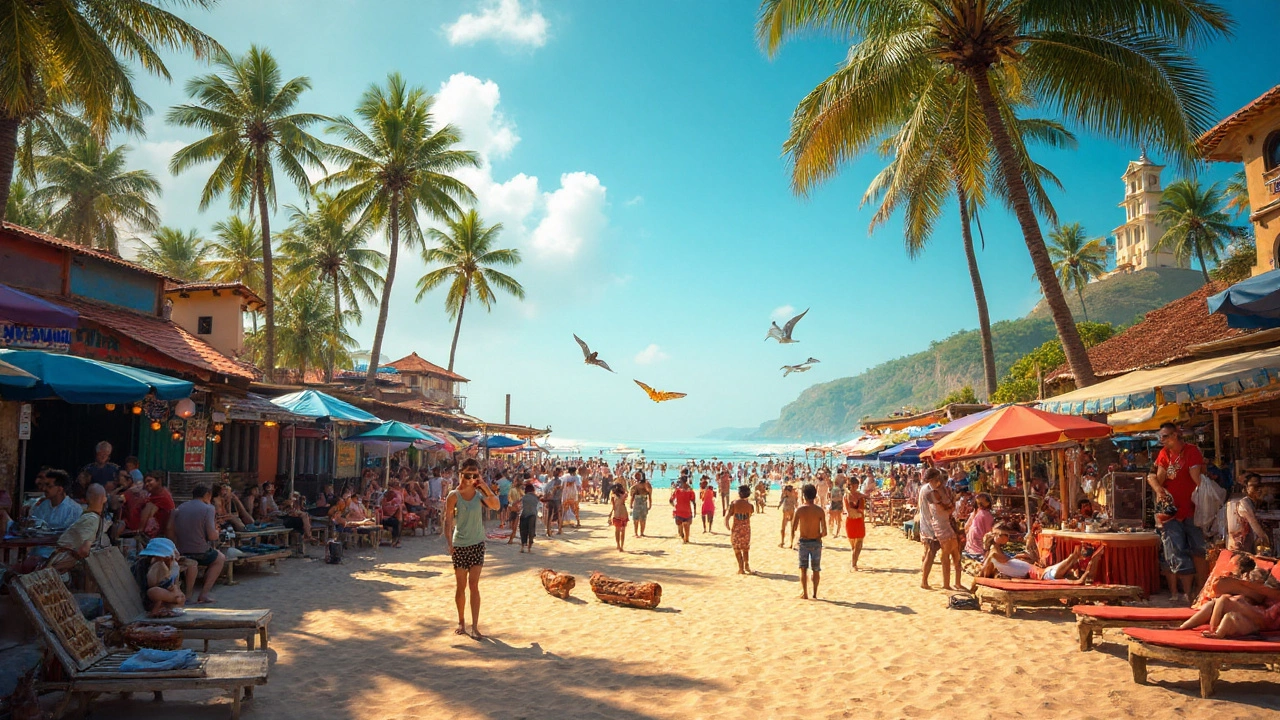Ask a regular traveler—or someone obsessed with their next sun-soaked escape—about India’s most famous beach for international visitors, and you’ll hear the same answer almost every time. It’s always Goa. But what makes this slice of coastline stand out, especially for foreigners who could pick thousands of sandy spots around the world? It’s not just the palm trees or even the cheap cocktails. There’s a heady mix here: laidback attitude, killer food, festival scenes that rival anywhere, and a warm welcome that keeps people coming back for seconds (and thirds).
Why Goa Rules India’s Beach Scene for Foreign Visitors
Goa’s beaches have a vibe that’s impossible to fake. Since the hippie trail days in the 1960s, travelers from Europe, Australia, South America, and everywhere in between have drifted here, hoping for calm seas and big parties. The top draw? Baga Beach. If you stand on that sweeping arc of golden sand any December, you’ll hear Russian, Portuguese, Spanish, German, and English in about the same breath.
But there’s more to the story than just Baga. Anjuna, Vagator, Arambol, and Palolem beaches each have their international niches. Arambol is known for its yoga crowd and drum circles. Palolem is that postcard-perfect tranquil cove where you’ll find people tapping away on laptops between sea swims. Yet, numbers paint a clear picture: Baga Beach sits on top. According to a 2024 survey by India's Ministry of Tourism, more than 65% of all foreign beach tourists spent at least one night near Baga or Calangute—often both since they’re next door neighbors.
So why do Goa’s beaches beat out all the competition, even when India’s coastline runs for 7,500 kilometers? The magic draws from a few features that set this state apart:
- Social Scene: Full moon parties that outlast sunrise, EDM festivals, flea markets—they’re legendary, and international crowds play a big part.
- Food and Drink: Beach shacks serve everything from spicy vindaloo to vegan Buddha bowls—and yes, beer is always cold.
- Accessibility: Goa’s international airport is just about 45 minutes from the main beaches. Direct flights from Dubai, London, Moscow, and more make the hop super easy.
- Safety: Compared to many other coastal regions, Goa generally maintains a chill and safe atmosphere, especially along the main beaches.
- Cultural Blend: Global music, Portuguese colonial heritage, and Indian traditions mix everywhere—from the street art in Anjuna to the music floating through Morjim.
It’s not just about where you lay your towel—people fall for the dismantling of daily routine. Many foreigners even come for long stays, renting scooters, learning to cook a decent fish curry, or taking river cruises up the Mandovi. Some end up staying for months; a few, for good.
Baga Beach: India’s Foreigner Magnet
Baga Beach wears the crown for international footfall, and it’s pretty easy to see why even if you’re not an avid beach bum. Wake up along Baga’s sand and there’s the sound of water taxis, chatter from nearby shacks, and the clink of morning chai glasses. The people-watching is fantastic—expect dreadlocks, yoga pants, sarongs, and the latest from Milan’s beachwear lines, all blending with locals and Indian tourists.
If raw numbers are your thing, check this stat: data from Goa’s Tourism Department showed in 2024, up to 920,000 international tourists visited Goa between November and March. The vast majority reported Baga Beach as their main destination. For context, that’s more than the population of Wellington, twice over, squeezed into season. That creates a swirling energy—sometimes a crush, but usually just the right amount of buzz.
What keeps those foreigners coming back, apart from the lively crowd? There are jet skis, banana boat rides, and all the water sports you can think of, but Baga isn’t just for thrill-seekers. You’ll spot retirees from Germany strolling early mornings, families from Israel hunting crabs at dusk, and digital nomads tucked into beachfront cafés using Goa’s surprisingly decent Wi-Fi. At night, Tito’s Lane—which is just a short walk from the sand—turns into one of India’s wildest clubbing strips, with global DJs and the occasional fire juggler lighting up the party.
Baga’s got a knack for convenience, too. ATM? Pharmacy? Surf school? It’s all there, plus shops selling everything from boho chic to international toothpaste. This is the place you’ll forget you’re halfway around the world—at least until you remember to look up at the coconut palms.
| Beach | Estimated International Visitors (2024) | Foreign Languages Commonly Heard |
|---|---|---|
| Baga Beach | 450,000+ | Russian, English, Portuguese, French, German |
| Anjuna Beach | 180,000+ | English, Russian, German, Hebrew |
| Palolem Beach | 140,000+ | English, French, Spanish |
Watch out for peak season prices, though. Around Christmas and New Year, costs can triple, and the luxury hotels fill up with backpackers and expats alike. One local tip: book directly with small guesthouses in the monsoon months (June–September) for super deals and a quieter, mossy vibe that makes you believe Goa’s still a secret.

Goa’s Other International Hotspots: Beyond Baga
If all your senses are telling you Baga’s a bit crowded, it’s time to sneak away and explore the lesser-trodden (well, slightly) sands nearby. Anjuna’s wild and rocky shore—home to the famous Wednesday flea market—draws artists, long-stay travelers, and wandering musicians. You might find a sitar jam right by the sea, or a painter capturing the candy-colored sunsets.
Then there’s Vagator, hugged by red cliffs and lined with smaller guesthouses. Many Russian and Israeli visitors return here every year, drawn by the relative peace and thriving trance parties. There’s even a thriving vegan food scene, with cafes like Bean Me Up making you forget you’re in India at all. If you’re into yoga and wellness? Arambol is the place—packed with classes, workshops, and holistic retreats set right by the gentle waves.
Further south, Palolem Beach has a reputation for a bit more serenity. Imagine a crescent of white sand fringed with palm trees, dotted with friendly beach huts. Here, it’s more about dolphin boat rides, lazy kayaking, or sampling homemade pierogi at a pop-up Polish eatery. The soundtrack is less pulsating club music, more gentle guitar and the hush of the sea. Palolem’s draw lies in its blend of chill, safety, and a surprisingly global food scene. Israeli shakshuka for brunch, Italian gelato for dessert, and a cold coconut every time you need to cool down.
Curious about crowd trends? Even as social media discovers quieter north Goa shores like Morjim and Ashvem, these spots stay sleepier and attract families and older travelers looking for less noise and a bit more space. You’ll have a hard time finding a good late-night party here, but if you value clean sand, fewer crowds, and tasty seafood, you’ll be all set.
- Tip: Use local taxis or rideshare apps instead of renting a moped if you’re not used to Indian roads—they can get quite wild.
- Order a fish thali at a small shack, not in the big beach clubs. The best food is always where locals eat.
- Pack more sunscreen than you think you need. Even on cloudy days, the sun is a trickster on the Goan coast.
- Embrace the off-season. If you’re adventurous, try visiting just after the monsoon. Fewer people, lusher landscapes, and way better deals.
What Makes Goa Irreplaceable for Foreigners?
It’s tempting to chalk all this up to pretty beaches, but Goa goes deeper. There’s a decade-spanning culture of tolerance, chill, and open-minded fun that doesn’t exist everywhere. Local Goans speak English alongside Konkani and Hindi, making life easy for even first-time visitors. People here have grown up seeing tourists every season for almost 60 years, so the welcome is relaxed and genuine, not forced or eager. Even the local police take pains to keep foreigners safe—special tourist police patrols are a thing, especially around Baga and Calangute.
But why do so many people end up extending their trip, sometimes for months? The easy pace of life is a big part. “Susegad,” the Goan motto, means a laidback, content feeling. You’ll see it in slow beach walks, friends hanging for hours over Kingfisher beers, and folks strumming guitars or painting shells for fun, not for Insta fame. Work-life balance makes more sense in Goa. That’s why the digital nomad scene roared back in recent years after the pandemic. Fiber internet, plenty of co-working spaces, and a chill pet-friendly attitude—Goa has quietly become India’s secret hub for remote workers from all over the planet.
Foreigners also love Goa for its wild festivals. From Christmas fireworks over Anjuna to Holi parties, Carnival in Panaji, and global trance festivals like Sunburn (which regularly draws 350,000 people over three nights), there’s always a big event lurking around the corner. And surprisingly, Goa’s prices (outside of major holidays) still let you eat, party, and sleep right next to the ocean without emptying your bank account. That’s rare for a spot this famous.
But the real reason? Goa feels easy to belong to. Whether you want to live simply by the waves, dance all night, or just make friends from half a dozen countries over a single breakfast, Goa puts down the welcome mat. Ask anyone who’s spent more than a week here, and chances are you’ll find them dreaming of their next sunshine escape—right back on the same stretch of Goan sand with a cold drink, good music, and the promise of another spectacular sunset.
